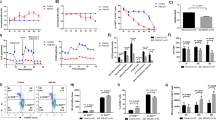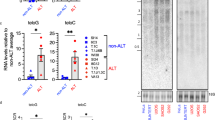Abstract
Persistent inhibition of telomerase induces a severe telomere shortening in human T-cell leukemia virus type-1-infected cells which signals a DNA double-strand break damage response, formation of telomere dysfunction-induced foci and activates the ATM pathway. In turn, activation of ATM and its downstream effectors led to an increased phosphorylation and acetylation on specific residues of p53 known to be involved in transcriptional activation. Disruption of Mdm2–p53 complexes coupled with increased proteasomal degradation of MDMX further enhanced reactivation of p53 transcription, ultimately leading to senescence of tumor cells. Induction of senescence in these T-cells was associated with an increased expression of p21, p16 and activation of GSK3β. Our results support the cancer–aging model and demonstrate that the halt of aging in cancer cells can be reversed through reactivation of p53.
This is a preview of subscription content, access via your institution
Access options
Subscribe to this journal
Receive 50 print issues and online access
$259.00 per year
only $5.18 per issue
Buy this article
- Purchase on Springer Link
- Instant access to full article PDF
Prices may be subject to local taxes which are calculated during checkout





Similar content being viewed by others
References
Bakkenist CJ, Kastan MB . (2003). DNA damage activates ATM through intermolecular autophosphorylation and dimer dissociation. Nature 421: 499–506.
Bellon M, Datta A, Brown M, Pouliquen JF, Couppie P, Kazanji M et al. (2006). Increased expression of telomere length regulating factors TRF1, TRF2 and TIN2 in patients with adult T-cell leukemia. Int J Cancer 119: 2090–2097.
Celli GB, de Lange T . (2005). DNA processing is not required for ATM-mediated telomere damage response after TRF2 deletion. Nat Cell Biol 7: 712–718.
Celli GB, Denchi EL, de Lange T . (2006). Ku70 stimulates fusion of dysfunctional telomeres yet protects chromosome ends from homologous recombination. Nat Cell Biol 8: 885–890.
Chehab NH, Malikzay A, Appel M, Halazonetis TD . (2000a). Chk2/hCds1 functions as a DNA damage checkpoint in G(1) by stabilizing p53. Genes Dev 14: 278–288.
Chehab NH, Malikzay A, Appel M, Halazonetis TD . (2000b). Chk2/hCds1 functions as a DNA damage checkpoint in G(1) by stabilizing p53. Genes Dev 14: 278–288.
Datta A, Bellon M, Sinha-Datta U, Bazarbachi A, Lepelletier Y, Canioni D et al. (2006). Persistent inhibition of telomerase reprograms adult T-cell leukemia to p53-dependent senescence. Blood 108: 1021–1029.
Gill PS, Harrington Jr W, Kaplan MH, Ribeiro RC, Bennett JM, Liebman HA et al. (1995). Treatment of adult T-cell leukemia-lymphoma with a combination of interferon alfa and zidovudine. N Engl J Med 332: 1744–1748.
Grassmann R, Aboud M, Jeang KT . (2005). Molecular mechanisms of cellular transformation by HTLV-1 Tax. Oncogene 24: 5976–5985.
Gu J, Kawai H, Nie L, Kitao H, Wiederschain D, Jochemsen AG et al. (2002). Mutual dependence of MDM2 and MDMX in their functional inactivation of p53. J Biol Chem 277: 19251–19254.
Haoudi A, Daniels RC, Wong E, Kupfer G, Semmes OJ . (2003). Human T-cell leukemia virus-I tax oncoprotein functionally targets a subnuclear complex involved in cellular DNA damage–response. J Biol Chem 278: 37736–37744.
He H, Multani AS, Cosme-Blanco W, Tahara H, Ma J, Pathak S et al. (2006). POT1b protects telomeres from end-to-end chromosomal fusions and aberrant homologous recombination. EMBO J 25: 5180–5190.
Hermine O, Bouscary D, Gessain A, Turlure P, Leblond V, Franck N et al. (1995). Brief report: treatment of adult T-cell leukemia–lymphoma with zidovudine and interferon alfa. N Engl J Med 332: 1749–1751.
Lambert PF, Kashanchi F, Radonovich MF, Shiekhattar R, Brady JN . (1998). Phosphorylation of p53 serine 15 increases interaction with CBP. J Biol Chem 273: 33048–33053.
Li C, Chen L, Chen J . (2002). DNA damage induces MDMX nuclear translocation by p53-dependent and -independent mechanisms. Mol Cell Biol 22: 7562–7571.
Liu L, Scolnick DM, Trievel RC, Zhang HB, Marmorstein R, Halazonetis TD et al. (1999). p53 sites acetylated in vitro by PCAF and p300 are acetylated in vivo in response to DNA damage. Mol Cell Biol 19: 1202–1209.
Matsuoka S, Huang M, Elledge SJ . (1998). Linkage of ATM to cell cycle regulation by the Chk2 protein kinase. Science 282: 1893–1897.
Matutes E, Taylor GP, Cavenagh J, Pagliuca A, Bareford D, Domingo A et al. (2001). Interferon alpha and zidovudine therapy in adult T-cell leukaemia lymphoma: response and outcome in 15 patients. Br J Haematol 113: 779–784.
Pan Y, Chen J . (2003). MDM2 promotes ubiquitination and degradation of MDMX. Mol Cell Biol 23: 5113–5121.
Park HU, Jeong JH, Chung JH, Brady JN . (2004). Human T-cell leukemia virus type 1 Tax interacts with Chk1 and attenuates DNA-damage induced G2 arrest mediated by Chk1. Oncogene 23: 4966–4974.
Park HU, Jeong SJ, Jeong JH, Chung JH, Brady JN . (2006). Human T-cell leukemia virus type 1 Tax attenuates gamma-irradiation-induced apoptosis through physical interaction with Chk2. Oncogene 25: 438–447.
Pise-Masison CA, Radonovich M, Sakaguchi K, Appella E, Brady JN . (1998). Phosphorylation of p53: a novel pathway for p53 inactivation in human T-cell lymphotropic virus type 1-transformed cells. J Virol 72: 6348–6355.
Poiesz BJ, Ruscetti FW, Gazdar AF, Bunn PA, Minna JD, Gallo RC . (1980). Detection and isolation of type C retrovirus particles from fresh and cultured lymphocytes of a patient with cutaneous T-cell lymphoma. Proc Natl Acad Sci USA 77: 7415–7419.
Ramos YF, Stad R, Attema J, Peltenburg LT, van der Eb AJ, Jochemsen AG . (2001). Aberrant expression of HDMX proteins in tumor cells correlates with wild-type p53. Cancer Res 61: 1839–1842.
Sabbatini P, McCormick F . (2002). MDMX inhibits the p300/CBP-mediated acetylation of p53. DNA Cell Biol 21: 519–525.
Shieh SY, Ikeda M, Taya Y, Prives C . (1997). DNA damage-induced phosphorylation of p53 alleviates inhibition by MDM2. Cell 91: 325–334.
Shvarts A, Steegenga WT, Riteco N, van Laar T, Dekker P, Bazuine M et al. (1996). MDMX: a novel p53-binding protein with some functional properties of MDM2. EMBO J 15: 5349–5357.
Siliciano JD, Canman CE, Taya Y, Sakaguchi K, Appella E, Kastan MB . (1997). DNA damage induces phosphorylation of the amino terminus of p53. Genes Dev 11: 3471–3481.
Sinha-Datta U, Horikawa I, Michishita E, Datta A, Sigler-Nicot JC, Brown M et al. (2004). Transcriptional activation of hTERT through the NF-kappaB pathway in HTLV-I-transformed cells. Blood 104: 2523–2531.
White JD, Wharfe G, Stewart DM, Maher VE, Eicher D, Herring B et al. (2001). The combination of zidovudine and interferon alpha-2B in the treatment of adult T-cell leukemia/lymphoma. Leuk Lymphoma 40: 287–294.
Acknowledgements
We would like to thank Dr G Lozano (University of Texas MD Anderson Cancer Center) for providing MDMX−/−, p53−/− MEF cells; Dr J Chen (H Lee Moffitt Cancer Center, Tampa, FL, USA) for MDMX expression plasmid and Diane L Persons, MD (University of Kansas Medical Center) for cytogenetic studies. This work was supported by grant R01CA106258 from the National Cancer Institute to C Nicot.
Author information
Authors and Affiliations
Corresponding author
Rights and permissions
About this article
Cite this article
Datta, A., Nicot, C. Telomere attrition induces a DNA double-strand break damage signal that reactivates p53 transcription in HTLV-I leukemic cells. Oncogene 27, 1135–1141 (2008). https://doi.org/10.1038/sj.onc.1210718
Received:
Revised:
Accepted:
Published:
Issue Date:
DOI: https://doi.org/10.1038/sj.onc.1210718
Keywords
This article is cited by
-
Tax impairs DNA replication forks and increases DNA breaks in specific oncogenic genome regions
Molecular Cancer (2014)
-
“Antivirals” in the Treatment of Adult T Cell Leukaemia– Lymphoma (ATLL)
Current Hematologic Malignancy Reports (2012)
-
HTLV-1 and apoptosis: role in cellular transformation and recent advances in therapeutic approaches
Apoptosis (2008)



